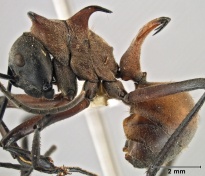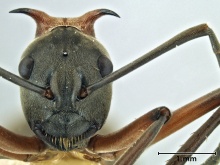Key to Polyrhachis (Polyrhachis) species
This key to Polyrhachis (Polyrhachis) species (based on the worker caste) is modified from Kohout (2014).
The species Polyrhachis dostali and Polyrhachis lacroixi where described after this key was published. See Key to Polyrhachis s.str. of the Malay Peninsula which includes these species.
Polyrhachis tonsilis was removed from synonym after this key was published and is therefore not included. It will key to Polyrhachis bihamata.
1
- Dorsum of mesosoma distinctly laterally marginate along its entire length; propodeal dorsum terminating in a pair of elongated, posteriorly directed, dorsally flattened, blunt spines (lamellidens species-group) => 2
- Dorsum of mesosoma immarginate or only partly obtusely marginate; propodeal dorsum terminating in a pair of short, upturned spines or medially directed, short ridges (bihamata species-group) => 3
2
- Petiolar spines widely divergent; extreme tips of mesonotal spines directed outwards; mesosoma and petiole distinctly light to medium reddish-brown => Polyrhachis lamellidens
 Head of Polyrhachis lamellidens worker |
 Profile of Polyrhachis lamellidens worker |
- Petiolar spines parallel for most of their length; extreme tips of mesonotal spines directed posteriorly; whole body black or very dark reddish-brown => Polyrhachis craddocki
 Head of Polyrhachis craddocki worker |
 Profile of Polyrhachis craddocki worker |
3
- Petiolar spines more-or-less divergent from bases => 4
- Petiolar spines virtually parallel for most of length => 8
4
- Smaller species (HL < 1.75); in dorsal view pronotal spines almost straight with tips directed anterolaterally (Papua New Guinea) => Polyrhachis taylori (in part)
 Head of Polyrhachis taylori worker |
 Profile of Polyrhachis taylori worker |
- Larger species (HL > 2.25); in dorsal view pronotal spines hook-shaped with tips directed posterolaterally or posteriorly => 5
5
- Pronotal spines massive, black throughout => Polyrhachis ypsilon
 Head of Polyrhachis ypsilon worker |
 Profile of Polyrhachis ypsilon worker |
- Pronotal spines slender, reddish-brown with black tips => 6
6
- Bases of mesonotal spines closely approximated => 7
- Bases of mesonotal spines widely separated (Borneo) => Polyrhachis montana
 Head of Polyrhachis montana worker |
 Profile of Polyrhachis montana worker |
7
- Smaller, slender species (HL < 2.37); antennal scapes with numerous hairs along leading and inferior edge; propodeal dorsum in profile about 2 × as long as distinctly concave declivity (Borneo) => Polyrhachis maliau
- Larger, more stoutly built species (HL > 2.62); antennal scapes with only occasional hairs present; propodeal dorsum in profile only about 1.5 × as long as oblique declivity (Philippines) => Polyrhachis mindanaensis
 Head of Polyrhachis mindanaensis worker |
 Profile of Polyrhachis mindanaensis worker |
8
- Smaller species (HL < 1.75) (Papua New Guinea) => Polyrhachis taylori (in part)
 Head of Polyrhachis taylori worker |
 Profile of Polyrhachis taylori worker |
- Larger species (HL > 1.78) => 9
9
- Propodeal dorsum terminating posteriorly in a pair of dorsoposteriorly directed, short, acute spines; petiole relatively high (PI 107 – 127); ocelli usually lacking => Polyrhachis olybria
 Head of Polyrhachis olybria worker |
 Profile of Polyrhachis olybria worker |
- Propodeal dorsum terminating posteriorly in a pair of blunt, medially directed, short ridges; petiole relatively low (PI 87 – 108); median ocellus always present, lateral ocelli often obscure => 10
10
- Head and gaster black or very dark reddish-brown; in dorsal view pronotal spines almost straight with tips projecting anterolaterally; smaller species (HL < 2.30) => 11
- Head dark reddish-brown or black; gaster light reddish-brown with apex dark brown; in dorsal view pronotal spines hook-shaped; with tips projecting posteriorly; larger species (HL > 2.35) => Polyrhachis bihamata
 Head of Polyrhachis bihamata worker |
 Profile of Polyrhachis bihamata worker |
11
- Generally smaller species (HL 1.78 – 2.12); eyes in full face view exceeding lateral cephalic outline; pronotal dorsum smooth and polished; pilosity and pubescence very sparse over all body surfaces => Polyrhachis bellicosa1
 Head of Polyrhachis bellicosa worker |
 Profile of Polyrhachis bellicosa worker |
- Generally larger species (HL 2.02 – 2.39); eyes in full face view not reaching or only marginally exceeding lateral cephalic outline; pronotal dorsum subopaque; pilosity and pubescence abundant over most body surfaces => Polyrhachis erosispina1
 Head of Polyrhachis erosispina worker |
 Profile of Polyrhachis erosispina worker |
1Polyrhachis bellicosa and P. erosispina are very similar but where they are sympatric, their morphological differences are somewhat accentuated. In allopatry, however, the differences are usually less distinct and there is no single diagnostic character that can be relied upon to separate them. A combination of characters has to be considered to differentiate both species successfully. The most reliable character appears to be the form of the petiolar column in some workers of P. bellicosa, in which the anterior section at the immediate base of the spines is swollen (see Kohout 1988, fig. 1A, C). However, besides the holotype, only a small percentage of workers in any particular population show this remarkable configuration and specimens intermediate to the more usual unswollen condition (see Kohout 1988, fig. 3E, F), are uncommon. The swollen condition has been observed in populations of P. bellicosa from various parts of New Guinea, but only where this species is sympatric with its closely related counterpart, P. erosispina. This has been confirmed to be repeated under the same circumstances of contact with P. erosispina in populations of P. bellicosa in eastern Indonesia. Presence of this phenomenon on Aru Island is confirmed by the holotype itself and documentation of the presence of P. erosispina there by Karavaiev (1927). The Philippine record of P. bellicosa is from Mindanao, where a worker with a swollen node was collected with ‘normal’ specimens at the same locality as P. olybria, another species closely related to both, P. bellicosa and P. erosispina. The swollen node condition has never been observed in the Australian population of P. bellicosa, in spite of examination of many hundreds of specimens. This appears to be correlated with the absence of any closely similar species in Australia. It is unfortunate that this remarkable feature is relatively rare, for it is the most reliable character identifying P. bellicosa, even when other characters fail to distinguish the species from sympatric P. erosispina specimens.
Besides the characters given in the key and the form of the petiolar column, the more reliable diagnostic characters separating P. bellicosa from P. erosispina are as follows. The pronotal dorsum in P. bellicosa is distinctly narrowed anteriorly and more or less broadly rounded posteriorly, with the dorsum of mesonotum in profile, deeply and broadly impressed at the promesonotal suture. The mesonotal spines at their bases are almost pyramidal, with their apical portions more or less horizontal and their dorsal edges entire. In contrast, the pronotal dorsum in P. erosispina is only very slightly narrowed anteriorly, with the sides almost parallel. The promesonotal suture is only very narrowly impressed and virtually flat in profile. The mesonotal spines are lanceolate from their bases, with the apical portions usually recurved, and the dorsal edges frequently eroded.